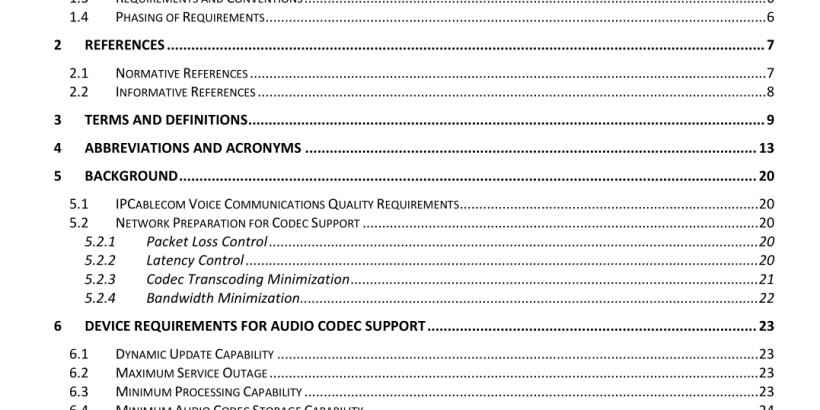ANSI SCTE 24-2-2016 pdf download.Audio Codec Requirements for the Provision of Bi-directional Audio Service over Cable Television Networks Using Cable Modems
3 TERMS AND DEFINITIONS
The following is a master list of terms and definitions used by IPCablecom 1.0:Limiting the flow of information from the resources of a system only to authorized persons, programs, processes or other system resources on a network. A service flow is said to be “active” when it is permitted to forward data packets. A service flow must first be admitted before it is active. A service flow is said to be “admitted” when the CMTS has reserved resources (e.g., bandwidth) for it on the DOCSIS network. A-Links are SS7 links that interconnect STPs and either SSPs or SCPs.‘A’ stands for “Access.” An encryption key or a decryption key used in public key cryptography, where encryption and decryption keys are always distinct. An Audio Server plays informational announcements in IPCablecom network. Media announcements are needed for communications that do not complete and to provide enhanced information services to the user. The component parts of Audio Server services are Media Players and Media Player Controllers. The process of verifying the claimed identity of an entity to another entity. The ability to ensure that the given information is without modification or forgery and was in fact produced by the entity that claims to have given the information. The act of giving access to a service or device if one has the permission to have the access. An algorithm that transforms data between plaintext and ciphertext. A set, which must contain both an encryption algorithm and a message authentication algorithm (e.g., a MAC or an HMAC). In general, it may also contain a key management algorithm, which does not apply in the context of IPCablecom. The (encrypted) message output from a cryptographic algorithm that is in a format that is unintelligible.
A set, which must contain both an encryption algorithm and a message authentication algorithm (e.g.. a MAC or an HMAC). In general, it may also contain a key management algorithm, which does not apply in the context of IPCablecom. The (encrypted) message output from a cryptographic algorithm that is in a format that is unintelligible. The original (unencrypted) state of a message or data. Also called plaintext. A way to ensure that information is not disclosed to anyone other than the intended parties. Information is encrypted to provide confidentiality. Also known as privacy. The process of recovering the plaintext of a message or the encryption key without access to the key. An algorithm used to transfer text between plaintext and ciphertext. A procedure applied to ciphertext to translate it into plaintext. A procedure applied to ciphertext to translate it into plaintext. The key in the cryptographic algorithm to translate the ciphertext to plaintext. A binding between an entity’ s public key and one or more attributes relating to its identity, also known as a public key certificate. A data value generated by a public key algorithm based on the contents of a block of data and a private key, yielding an individualized cryptographic checksum.
A unidirectional sequence of packets identified by ISO Layer 3 and Layer4 header information. This information includes source/destination IP addresses, source/destination port numbers, protocol ID. Multiple multimedia streams may be carried in a single IP Flow. Devices bridging between the IPCablecom IP Voice Communication world and the PSTN. Examples are the Media Gateway which provides the bearer circuit interfaces to the PSTN and transcodes the media stream, and the Signaling Gateway which sends and receives circuit switched network signaling to the edge of the IPCablecom network. An ITU-T recommendation for transmitting and controlling audio and video information. The H.323 recommendation requires the use of the ITU-T H.225 and ITU-T H.245 protocol for communication control between a “gateway” audio/video endpoint and a “gatekeeper” function.ANSI SCTE 24-2-2016 pdf download
